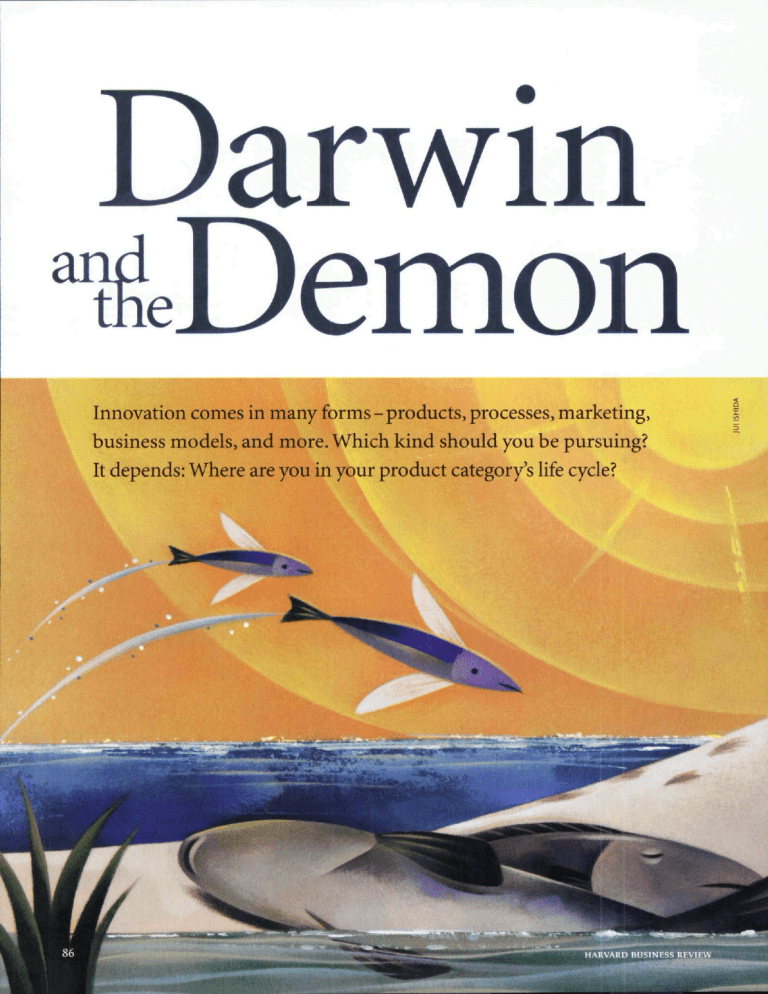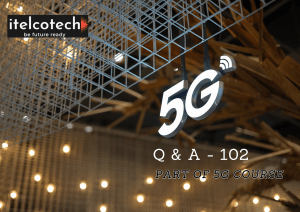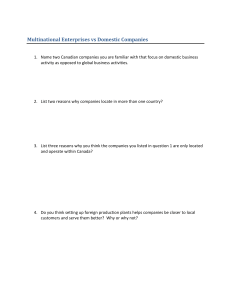
Darwin Innovation comes in many forms - products, processes, marketing, business models, and more. Which kind should you be pursuing? It depends: Where are you in your product category's life cycle? by Geoffrey A. Moore Innovating Within Established Enterprises s COMMERCIAL PROCESSES c o m m o d i t i z e in a developed economy, they are outsourced or transferred offshore or both, leaving onshore companies with unrelenting pressure to come up with the next wave of innovation. Failure to innovate equals failure to differentiate equals failure to gamer the profits and revenues needed to attract capital investment. It behooves us all to use our brains to get out in front of this Darwinian process. Innovating Within Established Enterprises For starters, we need to appreciate how broad the lished role in the value chain or both. Examples include domain of innovation really is. Sure, it includes the type chestnuts like Gillette's move from razors to razor blades, everyone knows about: disruptive innovation, the stuff IBM's shift to on-demand computing, and Apple's expanof technology legend and Silicon Valley lore. But we sion into consumer retailing. should not be blind to the existence of more mundane Structural Innovation. Capitalizes on disruption to reforms that are equally effecstructure industry relationtive, as the following taxonships. Innovators like Fidelity The implication of the life-cycle omy illustrates: and Citigroup, for example, model is that enterprises must have used the deregulation Disruptive Innovation. Gets a great deal of attention, parof financial services to offer mutate their core competences over ticularly in the press, because broader arrays of products time to sustain attractive returns. markets appear as if from noand services to consumers where, creating massive new under one umbrella. Nearly sources of wealth. It tends to have its roots in technologiovernight, those companies became sophisticated comcal discontinuities, such as the one that enabled Motorpetitors to old-guard banks and insurance companies. ola's rise to prominence with the first generation of cell The breadth of this list can be problematic. How are phones, or in fast spreading fads like the collector card managers and executives to decide where to focus? Which game Pokemon. types of innovation should they pursue? There was a time when the notion of core competences was invoked to Application Innovation. Takes existing technologies into solve this problem: Pick the things you are best at and new markets to serve new purposes, as when Tandem focus your resources accordingly. But companies have disapplied its fault-tolerant computers to the banking marcovered that being the best at something doesn't guaranket to create ATMs and when OnStar took Global Positee a competitive advantage. A distinctive competence is tioning Systems into the automobile market for roadside valuable only if it drives purchase preferences. Customers assistance. frequently ignore companies' core competences in favor Product Innovation. Takes established offers in estabof products that are good enough and cheaper. lished markets to the next level, as when Intel releases a new processor or Toyota a new car. The focus can be on performance increase (Titleist Pro VI golf balls), cost reduction (HP inkjet printers), usability improvement (Palm bandhelds), or any other product enhancement. A more reliable way to solve the problem of focus is to think of different types of innovation as being privileged Process Innovation. Makes processes for established at different points in a market's life. The technology secoffers in established markets more effective or efficient. tor has provided ample material for studying the early Examples include Dell's streamlining of its PC supply phases of market development, and I've previously dechain and order fulfillment systems, Charles Schwab's scribed how those phases can be viewed through the lens migration to online trading, and Wal-Mart's refinement of the technology adoption life cycle (see the left side of of vendor-managed inventory processes. the graphic in the exhibit "The Market Development Experiential Innovation. Makes surface modifications Life Cycle"). By combining graphical representations of that improve customers' experience of established prodthat cycle and of wbat happens later when markets ucts or processes. These can take the form of delighters become more established, we can show market develop("You've got mail!"), satisfiers (superior line management end to end. The market development life cycle inment at Disneyland), or reassurers (package tracking cludes the following phases (the first four constitute the from FedEx). technology adoption life cycle for emerging markets): Marketing Innovation. Improves customer-touching processes, be they marketing communications (use of the Early Market. When a technology is introduced, it atWeb and trailers for viral marketing of The Lord of the tracts the attention of early adopters-enthusiasts (who Rings movie trilogy) or consumer transactions (Amazon's see it as cool) and visionaries (who see it as potentially dise-commerce mechanisms and eBay's online auctions). ruptive). Pragmatic buyers are curious but make no commitments. The press, fascinated, writes glowing articles Business Model Innovation. Reframes an established describing the technology as the next big thing. value proposition to the customer or a company's estabThe Chasm. The technology is caught betwixt and beGeoffrey A. Moore (gmoore@tcg-advisors.com) is a manag- tween. Because it has been in the marketplace for some ing director ofTCG Advisors in San Mateo, California, and a time and has lost its novelty, visionaries are no longer venture partner v^ith Mento Park, California-based Mohr, making big bets on it. But its acceptance isn't widespread Davidow Ventures. His most recent book is Living on the enough to convince pragmatists that it would be a safe purchase. Adoption is stalled, and typically the only way Fault Line (HarperBusiness, 2002). Riding the Life Cycle HARVARD BUSINESS REVIEW I n n o v a t i n g W i t h i n Established for vendors to move forward is to target a niche market that suffers from a nasty problem for which the technology is the sole solution. The "pragmatists in pain" in such a market are the only customers motivated to help the new technology cross the chasm. Current examples of technologies in the chasm include third-generation wireless, on-demand computing, and fuel cells. Bowling Alley. The technology is gaining acceptance among pragmatists in one or more niche markets where it enables a solution to a nasty problem (when a niche adopts the technology, adjacent niches become more susceptible-hence the bowling pin metaphor). Within each niche, it is building a loyal following and attracting partners who see a market in the making. Outside the niches, it is still largely unknown. Tornado. The technology has passed the test of usefulness and is now perceived as necessary and standard for many applications. All the pragmatists who were hanging back from committing are rushing into the market to make sure they don't get left behind. Customers of many types from many fields are making their first purchases of the technology, and revenues are growing at doubleor even triple-digit rates. Competition is fierce, with investors bidding up the stock of every company that can participate in the category. Main Street (Early). The era of hypergrowth has subsided, but the category is still growing nicely. A first wave of consolidation results in a market-share pecking order that is unlikely to change for a long time. Even the companies with small market shares are typically performing The Market Development Life Cycle Enterprises well. Customers are focused on seeing systematic improvements in the offering and reward each with an uptick in purchasing. Main Street (Mature). Category growth has fiattened, and commoditization is increasing. A second wave of consolidation thins out the bottom of the pecking order, with market leaders creating top-line growth both organically and through M&A. Customers now take the category for granted, and the press no longer writes about it. On the plus side, however, there are no ohsoleting technologies on the horizon, so market risk is at a nadir. Main Street (Declining). The category has become ossified, and the market dominators are unresponsive to customer needs. Customers are actively looking for relief, a development that is attracting entrepreneurs. The nextgeneration technologies are on the horizon, although none has gone through the tornado. The market is ripe for some form of disruption, either through an obsoieting technology or a radically innovative business model. Fault Line and End of Life. Technology obsolescence has struck like an earthquake, exposing the fault line between what the company sells and what the market now desires. The next-generation tornado is wreaking havoc on the installed bases of the established vendors. There is no path forward for companies that produce the obsolete technology, and the only question left is how much money existing customers are willing to spend on the category before it vanishes altogether. Leveraged buyouts become an attractive mechanism for monetizing this remaining market opportunity. Indefinitely Elastic Middle Period Main Street (Declining) Tornado Bowling Alley The Chasm Early Market End of Life Technology Adoption Life Cycle Time TOP-LINE GROWTH JULY-AUGUS i' 2OO4 89 Innovating W i t h i n Established Enterprises three types can interoperate, and thus they can be used separately or together to create incremental improvements. Sooner or later, even these forms of innovation lose their usefulness and the market moves into an inevitable decline, often with the further threat of an obsoleting technology on the horizon. But companies still have two types of innovation left to exploit: business model and structural. As markets are commoditizing at one point in the value chain, they are decommoditizing somewhere else (another fine insight from Mr. Christensen). For example, in the automotive industry today, normal maintenance is commoditizing as roadside services are decommoditizing. A nimble enterprise may be able to leverage its reputation with customers to reinvent itself and address their needs in a dramatically different fashion. In its mild form, reinvention grafts a new business model onto the old infrastructure. In its draconian form, it involves a radical restructuring of the enterprise. It's a high-risk endeavor either way, but with the market nearing the fault line, reinvention is the only path forward. The alternative is for executives to call the game over, accept that the market is at the end of its life, and allow the company to be bought by investors who plan to focus on distributing rather than reinvesting the remaining free cash fiows. Seeing the Whole Picture If we overlay our catalog of innovation types onto the market life-cycle model, we can see that at each stage, management has different resources to bring to the challenge of competing for revenues and profit margins. (See the exhibit "Aligning Innovation with the Life Cycle.") The first three innovation types - disruptive, application, and product - dominate the technology adoption life cycle, interoperating to bring about the creation of the new market category. Until the tornado has blown itself out, no other kind of innovation focus is rewarded. Once the market moves onto Main Street, however, these forms of innovation lose their leverage. Any delta in competitive advantage they might produce wouldn't be worth the resources required. To put it another way, the marketplace is no longer willing to yield the revenue or margin gains necessary to fund such efforts. (Investments in these types of innovation during the Main Street phases of the market's life have the effect of accelerating commoditization through a process Clay Christensen has called overshooting.) At this point in the market's evolution, a second suite of innovation types comes to the fore -the group consisting of process, experiential, and marketing. Again, the Aligning Innovation with the Life Cycle Experiential Innovation Process ^^fl Innovation ^^^^B \ \ Product Innovation Application \ ^ Innovation \ ^^k Disruptive \ J^^| N^^^^^^H Revenue Grov Innovation lime 90 HARVARD BUSINESS REVIEW I n n o v a t i n g W i t h i n Established All in all, then, despite the commoditizing pressures of globalization, management has a surprisingly robust set of opportunities to create shareholder value. Yet few CEOs sleep easy, for their dreams of success are haunted by an unnerving specter, the demon of inertia. Enterprises Choosing the Right Leader Innovation Type Team's Executive 5ponsor Best Team Leader Disruptive General manager Entrepreneur (any function) Battling Inertia Application General manager Marketing manager Product General manager Engineering manager The implication of the life cycle model is that enterprises must mutate their core competences over time to sustain attractive returns. Product-innovation skill, which serves a company wonderfully in a market's early stages, will not sustain it on Main Street, where new expertise in process management and marketing is needed. But management's efforts to change direction are thwarted by the inertia that success creates. The deeper the enterprise is into the life cycle and the more successful it has been, the greater its tendency to return to its former course. For most executive teams, battling the inertia demon is the biggest challenge they face. Sad to say, the demon usually wins. Process VPfor operations Operations manager Experiential VP for marketing Customer service manager Marketing VPfor marketing Marketing manager Business model CEO General manager Structural CEO General manager To overcome inertia, management must introduce new types of innovation while deconstructing old processes and organizations. The most common mistake executive teams make when they seek to introduce change is leav- Marketing Innovation Business Model Innovation Structural Innovation TOP-LINE GROWTH JULY-AUGUST 2004 ing legacy structures untouched. Their hope is that the success of the new will draw resources away from the old and allow change to occur organically and painlessly. This approach has little chance to succeed. The way to move forward is to aggressively extract resources from legacy processes and organizations and repurpose them to serve the new innovation type, or, if that's not possible, take them out of the company altogether. So management must pursue a twofold path of concurrent construction and deconstruction. For construction, the goal is to create the next generation of competitive advantage, so the focus should be on the innovation team. It should be sponsored by a senior executive and led by someone who is passionate about, and expert in, the new type of innovation. The choice of sponsor and leader will depend on which type of innovation the team is pursuing, as the exhibit "Choosing the Right Leader" illustrates. Note how executive sponsorship migrates over the life cycle. During the middle part of a category's life, innovation can be sponsored at the VP level. But it needs the attention of the general manager during the early part of the market's development, and the company-transforming innovations of the late stages demand the full support of the CFO. The team leader should probably be recruited from outside the firm, because he or she must be a world class performer-and the company's best talent is usually associated with its legacy competences. The rest of the team, by contrast, should be made up of highpotential individuals from inside so that the new effort is grounded in the realities of the business and, over the long term, human capital is extracted from the legacy processes. 91 Innovating Within Established Enterprises Defeating the Demon The challenge of deconstruction is that the legacy work still needs to be done, but because it no longer drives customer purchase preferences, resources deployed in support of it do not improve market results. These resources are merely preventing the downside consequences of underperformance. Legacy deconstruction should therefore be driven by a simple mantra: Productivity, not differentiation. Differentiation that does not drive customer preference is a liability. Once a company's people fully internalize this principle, the path forward is clear; 1. Centralize the Junction. Legacy processes are typically embedded in each of the enterprise's operating units. Bring them together under a shared-services model, and put an operations-focused manager in charge. This will free resources that are performing duplicate functions. 2. Standardize the process. More often than not, processes pulled together into a shared-services model retain their idiosyncrasies. Invoke the mantra to standardize them into a single process set. Users will scream. Plug your ears. The resources that are no longer needed for maintaining multiple versions will more than pay for your troubles. 3. Simplify the process. Once processes have been standardized, they can be simplified in a leveraged way. just make sure that during the course of process redesign, people do not try to innovate (it is a powerful human urge, after all). The idea is to take resources out, not put more in. 4. Automate or outsource the process. Make the processes go away, either by embedding them in computer transactions or exporting them to a firm for which they will be a source of revenue instead of a drag on profits. Because you have already centralized, standardized, and simplified, the good news here is that you have reduced both the expense and risk of this step. It's important to recognize that differentiation-creating innovation and productivity-creating deconstruction must be conducted in tandem. If you try the former without the latter, the inertia demon defeats you. If you try the latter without the former, you do nothing to overcome the forces of commoditization; you are simply able to endure them longer. By running the two efforts in parallel, and migrating resources from legacy processes to innovation wherever possible, you not only improve your returns in the marketplace, you renew and rejuvenate the company. Neither Darwin's forces nor the demon's will defeat you. ^ Reprint R0407F To order, see page 'He's great at getting his foot in the door." 92 HARVARD BUSINESS REVIEW Copyright 2004 Harvard Business Publishing. All Rights Reserved. Additional restrictions may apply including the use of this content as assigned course material. Please consult your institution's librarian about any restrictions that might apply under the license with your institution. For more information and teaching resources from Harvard Business Publishing including Harvard Business School Cases, eLearning products, and business simulations please visit hbsp.harvard.edu.






